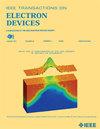High-Performance Enhancement-Mode GaN p-FET Fabricated With an Etch-Stop Process
IF 2.9
2区 工程技术
Q2 ENGINEERING, ELECTRICAL & ELECTRONIC
引用次数: 0
Abstract
The gate recess process for the enhancement-mode (E-mode) gallium nitride (GaN) p-FET is expected to create a high density of crystalline defects; thus, a large用蚀刻停止工艺制备高性能增强型GaN p-FET
增强模式(e模式)氮化镓(GaN) p-场效应管的栅极凹槽工艺有望产生高密度的晶体缺陷;因此,较大的$\vert {V}_{\text {th}} \vert $通常伴随着较差的Ion。为了解决这一挑战,在这项工作中,开发了一种蚀刻停止工艺,在p-GaN层中插入1.5 nm的AlN层,因此基于干蚀刻的栅极凹槽终止于AlN层。然后使用湿蚀刻去除凹槽区域的AlN,因此在干蚀刻期间屏蔽栅极通道的表面免受等离子体轰击。所制备的蚀刻停止GaN p-FET具有较大的${V} _{\text {th}} = -4.9$ V,高离子为6.79 mA/mm,小的${V} _{\text {th}}$迟滞为0.2 V,高离子/ off比为106。此外,在同一外延晶片上制作了一个e模n沟道场效应管,以证明所提出的蚀刻停止p场效应管技术在GaN互补逻辑(CL)中的潜力。因此,在这项工作中展示的技术被证明是解决用于CL应用的GaN p-FET中${V} _{\text {th}}$ -Ion权衡的有效方法。
本文章由计算机程序翻译,如有差异,请以英文原文为准。
求助全文
约1分钟内获得全文
求助全文
来源期刊

IEEE Transactions on Electron Devices
工程技术-工程:电子与电气
CiteScore
5.80
自引率
16.10%
发文量
937
审稿时长
3.8 months
期刊介绍:
IEEE Transactions on Electron Devices publishes original and significant contributions relating to the theory, modeling, design, performance and reliability of electron and ion integrated circuit devices and interconnects, involving insulators, metals, organic materials, micro-plasmas, semiconductors, quantum-effect structures, vacuum devices, and emerging materials with applications in bioelectronics, biomedical electronics, computation, communications, displays, microelectromechanics, imaging, micro-actuators, nanoelectronics, optoelectronics, photovoltaics, power ICs and micro-sensors. Tutorial and review papers on these subjects are also published and occasional special issues appear to present a collection of papers which treat particular areas in more depth and breadth.
 求助内容:
求助内容: 应助结果提醒方式:
应助结果提醒方式:


